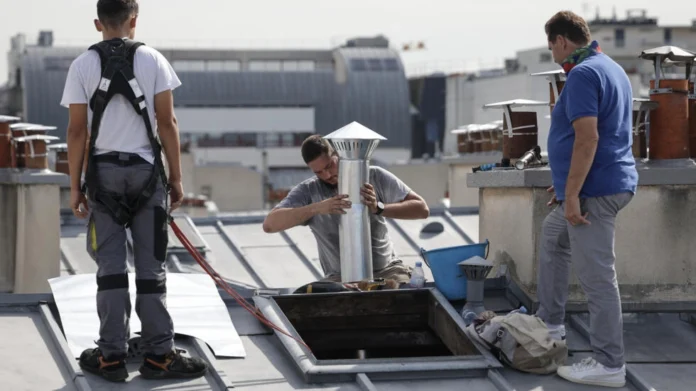
Paris’s iconic zinc roofs, which have defined the city’s skyline for nearly two centuries, are at the heart of a compelling story of heritage and adaptation.
The French culture ministry has put forward the roofers who maintain these distinctive coverings as the country’s entry for UNESCO’s Intangible Cultural Heritage list.
This move, set to be decided at the UN body’s session in Asuncion, Paraguay, in December, aims to recognize the craftsmanship that shapes Paris’s architectural character.
However, the profession is facing modern challenges as it adapts to the realities of climate change.
Heritage Status and Historical Significance
The zinc roofs of Paris are more than just an aesthetic feature; they are a symbol of the city’s historical identity.
Covering approximately 80 percent of the capital’s 128,000 roofs, the zinc contributes to Paris’s signature grey hue, setting it apart from other cities.
Delphine Burkli, mayor of Paris’s ninth district, played a key role in initiating the bid to add these roofs to UNESCO’s heritage list.
Her enthusiasm highlights the cultural importance of the roofs, asserting that Paris’s skyline, viewed from above, unmistakably reflects its unique urban character.
Yet, the path to UNESCO recognition has not been straightforward. The initial proposal to list the roofs ran into difficulties when Paris City Hall withdrew its support, fearing that such a designation might impede future urban development.
Gilles Mermet, the bid coordinator, explained that the focus shifted from protecting the roofs themselves to showcasing the profession behind them.
The aim is to highlight the craft of roofers, who play a crucial role in maintaining the city’s architectural integrity while grappling with contemporary challenges.
The Modern Challenges
The profession of roofers faces a dual challenge: a shortage of skilled workers and the impact of climate change.
According to Meriadec Aulanier, a representative of the plumbing and climate engineering trade union, Paris is short by around 500 roofers daily.
This shortage underscores the need to attract and train new professionals in a field struggling to maintain its traditional practices while adapting to modern demands.
One pressing issue is the role of zinc roofs in exacerbating the urban heat island effect. A study conducted by Paris’s urbanism agency Apur in 2022 revealed that 42 percent of Parisian roofs have poor heat reflection capacities.
This contributes to increased indoor temperatures during summer heatwaves, a growing concern as global temperatures rise.
Roofscapes, a French start-up, conducted a 2023 experiment highlighting how zinc roofs can trap heat, raising internal temperatures by up to 10 degrees Celsius compared to outside temperatures.
Climate Adaptation and Innovation
To address these issues, the roofing industry is exploring several adaptation strategies. Eytan Levi, an architect and co-founder of Roofscapes, points out that while zinc itself is not the problem, the lack of insulation in older buildings exacerbates overheating.
Modern roofing training programs now emphasize the importance of integrating insulation to mitigate these effects.
One proposed solution is repainting existing zinc roofs with lighter-colored paint to reflect more heat. However, this idea has been met with resistance from some in the industry.
Mermet argues that such measures could increase restoration costs and face practical challenges, such as paint degradation due to weather conditions.
The bid for UNESCO recognition aims not only to preserve the cultural significance of Paris’s zinc roofs but also to spotlight the evolving nature of the roofing profession.
The effort to include the craftsmanship in the heritage list reflects a broader recognition of how traditional skills are adapting to contemporary challenges.
By emphasizing the role of roofers in maintaining the city’s architectural heritage, the bid seeks to secure a place for this unique aspect of Paris’s skyline in the global cultural landscape.
Looking Forward
As the December decision approaches, the campaign to recognize Paris’s zinc roofers as part of UNESCO’s Intangible Cultural Heritage highlights the intersection of tradition and modernity.
The city’s iconic roofs, with their rich history and contemporary challenges, stand as a testament to the ongoing evolution of Paris’s architectural identity.
Whether or not the bid succeeds, the effort has already brought attention to the vital role of roofers in preserving the city’s historic charm while addressing the pressing issues posed by climate change.
In conclusion, Paris’s zinc roofs represent more than just a building material—they are a symbol of the city’s heritage and a reflection of the ongoing challenges faced by the profession.
The bid for UNESCO recognition is an opportunity to honor this tradition while acknowledging the need for adaptation in the face of a changing climate.
As Paris continues to navigate these challenges, the spotlight on its roofers serves as a reminder of the delicate balance between preserving history and embracing the future.